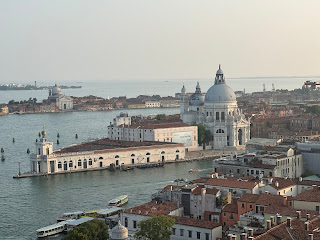We took a train from Milano Centrale to Venice Mestre, which is about a 2.5-hour ride. Our Meininger hotel was 500 meters from Mestre station. The hotel room was very spacious. Even though the hotel is a bit minimalist, it has a full-service bar and breakfast buffet. It is also conveniently located one block away from the bus stop to Venezia Santa Lucia.
To get in and out of the Venice islands, we bought the 48-hour bus + boat pass for 35 EUR. There’s also a 24-hour pass for 25 EUR. You can download their app here for more information. Unfortunately, you can only buy the pass electronically via WhatsApp. Otherwise, you can purchase the physical pass from shops in the train station, but they only took cash, so we chose to use the automated machines located at the bus stops outside the train station. I strongly recommend buying the pass because it allows you to use the water buses that take you to any of the Venice islands.
Once we reached the bus stop on the main island (Piazzale Roma), you walk to the water bus platforms and look for the one that takes you to San Marco. For instance, you can take Line 2 and get off at the Rialto stop, then walk over to San Marco Palace. Google Maps will help you find the best route, including which water bus lines to take.
St Mark's Square
We visited the Basilica di San Marco and also took the lift up to the Campanile di San Marco for 10 EUR. I was surprised there was very little line, as the view from the top is amazing. If it’s too crowded, you can buy skip-the-line tickets for specific times here.
 |
| View from Campanile di San Marco |
We walked around San Marco, took some pictures, and then headed back to our hotel—which felt like leaving Disney World: walking to the water bus stop, taking the water bus, and then the bus to our hotel. In our case, the bus was always standing room only.
The second day we did the same to return to the main island. We visited Murano by taking Line 4.2. At Murano, we visited the Original Murano Glass Factory. This was really worth it. You have to pay 5 EUR for the tour, but there are many other factories you can visit as well.
 |
| Murano |
From Murano, we headed to Giudecca, also using the 4.2 water bus. From Giudecca, we took Line 2 to the island directly across from San Marco. From there, we took Line 1 to return to the San Marco stop. We then walked to the Gondola San Marco stop in Bacino Orseolo (right next to Hard Rock Café). There are many locations where you can take gondolas, but we chose this one because it goes mainly through inner canals that are shaded. It does go through the Grand Canal but doesn’t pass under the Rialto Bridge—just next to it (at least on the 30-minute ride). Gondola San Marco seems to be the most common service and charges 90 EUR for a 30-minute ride for up to 5 people (increasing to 110 EUR after 7 p.m.). You can identify them by the signs with their published rates and they only take cash.
 |
| Gondola San Marco |
In many ways, going to Venezia feels like going to Disney World. It can get very crowded. We visited in early June, and it wasn’t too bad. Except for a couple of water buses—especially the ones from Piazzale Roma or Rialto—we were able to find seats. It can also take a while (~1 hour) to get in and out of the main island, especially from San Marco. The alternative is staying in a hotel on the island itself, and there are many to choose from. I just didn’t want to deal with luggage transfers, but a lot of people do it.
Venezia feels like a maze—it’s fun to walk around, and we only covered a small portion in 1.5 days. You could easily spend 2–3 days if you want to visit it more thoroughly.
Also, don’t forget that even though you’re exempt from the Venezia Tourist Tax if you’re staying at a hotel within the Venice metropolitan area, you still have to fill out an exemption form.
<< Day 3 (Lake Como) | Trip Itinerary | Day 6 (Assisi) >>























